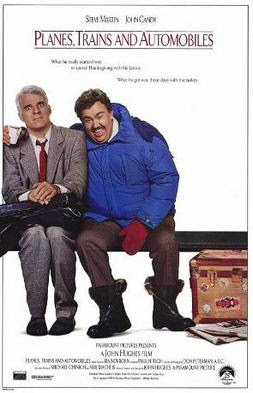Thanksgiving is here so let's stuff the bird, stuff ourselves, watch football games we could care less about and dust off our old VHS tape of "Planes, Trains and Automobiles" and drop it into our virtual VCR. "Planes" is John Hughes' 1987 holiday classic about Neal (Steve Martin) and Dell (John Candy) and their epic three-day journey to get Neal home from Manhattan for Thanksgiving dinner with his family. Along the way, they rent an automobile. Well, Dell does.
Dell doesn't rent just any automobile, though. He rents the biggest four-wheel joke of the 1980's - a Chrysler LeBaron Town and Country convertible. A car as perfectly cast as the foil for John Candy's comedic brilliance as the Trans Am added to Burt Reynolds' machismo-cool in "Smokey and The Bandit" and what the cheesy-exuberance of the DeLorean in "Back to the Future" did for Michael J. Fox.
Producers of "Planes" used a total of six "automobiles" in the movie - a combination of stock, woodie-free Chrysler LeBaron's and Dodge 600 convertibles. For the record, Dodge 600's never came optioned as woodies. Apparently as an homage to the "Wagon Queen Family Truckster" from National Lampoon's, "Vacation", the cars were painted lime-green; the simulated wood grain applique and plastic molding trim added afterwards. John Hughes wrote the short story that "Vacation" was based on.
Chrysler executives at the time, and we have to assume, included the lordly Lee Iacocca (above), were none-too-fond that one of their models crushed, smashed, made fun of and ultimately incinerated. That, and for all intents and purposes, a "clown car". Any car could have been the "automobile" in "Planes" - why'd they go to the extraordinary efforts of gussying up the cars for the movie? Plain and simple - because they were funny looking. Could Chrysler's hesitancy also have been because they knew their K-car based LeBaron "woodie" convertible was, being kind, a polarizing design and concept?
Somewhat amazingly if not stupefyingly so considering how unique and distinctive the LeBaron woodies were, Chrysler stiffs were ok with the use of the cars in the film if no Chrysler branding was visible - as if no one would be able to tell what they were. Hence, producers removed all Chrysler badges and, poking fun, affixed "Gran Detroit" to the flanks of the cars - the unofficial, official name of the car was, "Gran Detroit, Farm and Country Turbo". The only labeling on the car original to it the "TURBO" badges on the back of the front fenders denoting the turbocharged, 2.2-liter Chrysler engine under the hood. It's not clear if the car in this shot was originally a Chrysler LeBaron or Dodge 600; the 600 had a six-inch longer body. The cars had somewhat different front ends and used different taillight lenses.
Keen-eyed K-car fans know that the car in this scene is a Dodge 600 gussied up to look like a Chrysler LeBaron woodie. It's longer body giving the stubby car somewhat better design proportion and balance. Somewhat. There's only so much designers could do with these cars.
This car here is clearly a Chrysler LeBaron woodie. Sorry, "Farm and Country". Dang it - "Town and Country".
The original Chrysler LeBaron K-car convertible debuted in 1982 and added some calculated whimsy to a staid lineup. The "woodie" Town and Country models, which came out in 1983 and were offered for sale through 1986, were, frankly, a long putt if you weren't of the age to appreciate what Chrysler was attempting to do with them. That being to ape the haughty Town and Country's of the late 40's and 50's (note the old car in the background in the above ad). Again, being kind, the design was half-baked at best, off-putting at worst. Look closely enough and you can see Ricardo Montalban rolling his eyes.
Woodies aside, historically, the 1982-1986 LeBaron convertible was significant because it was the first Chrysler branded convertible since 1970 and the first factory-built convertibles sold by a domestic manufacturer since the 1976 Cadillac Eldorado. Frankly, having had a literal front row seat through the entire Chrysler K-car and LeBaron woodie saga, there's not much I can conjure up to say positively about them. Sorry, Captain Gen X over here, I wasn't a fan. I'm still not, although, could any other then-contemporary car have been the "automobile" in "Planes, Trains and Automobiles?"
Greeted with critical acclaim upon release, "Planes" was quite the accomplishment for John Hughes as he was construed in Hollywood as nothing but a teen angst filmmaker at the time (Sixteen Candles, Ferris Bueller, Breakfast Club etc). Siskel and Ebert gave it two thumbs up declaring it John Candy's best role to date. "Planes, Trains and Automobiles" has 94% positive rating on Rotten Tomatoes and is featured on Roger Ebert's "Great Movies" collection.











No comments:
Post a Comment